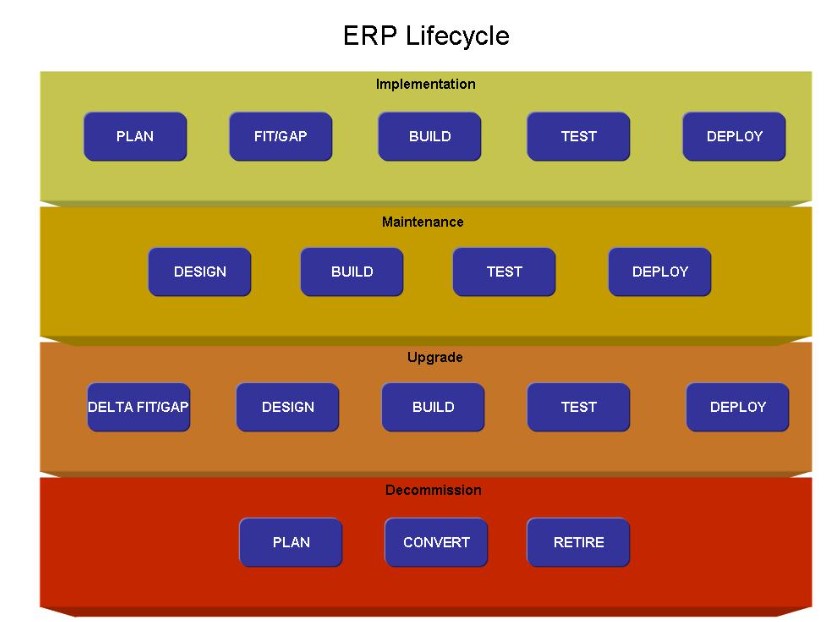I am very excited about Cloud ERP and the potential opportunities for customers, however, I like to speak to the minority opinion for a balanced discussion. Just as ERP was deemed the panacea for all business automation pains, Cloud ERP is positioned as a revolutionary approach to deploying an ERP solution. Cloud ERP provides a solution that is flexible, adaptable, scalable, efficient, and affordable. Customers can enjoy painless upgrades, rapid deployment, and easy customization along with availability “anywhere at anytime”! Practically speaking, Cloud ERP is just another deployment option available to customers. The activities required for an “on premise” ERP implementation are also required for Cloud ERP. The scope and responsibility for the implementation activities may be different but most assuredly they are still required. Let’s further discuss the key impacts that a Cloud ERP deployment will have on the implementation. For our discussion, we will refer to the following standard ERP life cycle.

ERP Life Cycle: Implementation
A repeated value proposition for Cloud ERP is a quicker implementation and deployment. However, it is important to note that technology has a limited impact on accelerating implementations. The deployment approach for cloud will naturally encourage a fixed, limited implementation scope – however, this is not unique to Cloud ERP. I agree that from a technology perspective Cloud ERP offers a faster installation timeframe. Nevertheless, it is important to note that Cloud ERP is only one component of a business solution. There are still multiple disciples required for a Cloud ERP implementation – especially organizational change management. Cloud ERP can provide very robust functionality but if the organization is not prepared to properly use the software then the value of Cloud ERP will quickly dissipate. Also, note that data conversion and the quality of the data converted will have a significant impact on both the speed and value cloud ERP can provide. Third, integration will be a greater challenge in a Cloud ERP model versus an on-premise ERP model – if only because the Cloud ERP will be outside the company’s internal network. Now, let’s consider the impacts Cloud ERP will have on the maintenance life cycle.
ERP Life Cycle: Maintenance
There are two areas of consideration for the Cloud ERP deployment model: customizations and integrations. These two areas are impacted based upon the cloud model. Following is a summary of the most common cloud models.

The key consideration is whether the customer has a dedicated software instance or a shared software instance. In general, a customer will have greater flexibility with integrations and customizations if the customer has a dedicated instance. If multiple customers are on single software then the Cloud ERP provider may limit the level of integrations and customizations because the software changes may have an adverse impact on all the customers on a shared instance.
ERP Life Cycle: Upgrade
ERP upgrades are necessary for software maintenance compliance and generating opportunities for greater return on investment. The responsibilities may shift for performing the technical upgrade, however the customer must provide resources for providing input to the delta fit/gap process, conducting organization change, testing, and validation. Another key consideration is if the customer has any flexibility on the frequency and timing of ERP upgrades. Lack of flexibility may result in the customer managing to the Cloud ERP vendor’s timetable.
ERP Life Cycle: Decommission
In general, the typical ERP life span is 10 years. As most customers are “going concerns” focused on growing and becoming more successful, it is important to consider the options available to move across delivery models. Consider the following illustration:

There is a relationship between customer size, integration requirements, customizations and ERP deployment models. As a customer matures and grows there will be a need for greater integration and customizations to address unique competitive requirements. Customers must balance cost and flexibility in selecting the right ERP deployment model.
Summary
Cloud ERP is providing additional opportunities for customers to leverage ERP as a viable option to support business operations – especially for smaller businesses with limited resources that require out-of-the-box functionality. However, it is important to remember that Cloud ERP is not a short cut to success. Responsibilities may change but the same activities are required to ensure a successful solution. As with every deployment model, there are advantages and disadvantages to consider. It is in the customer’s best interest to consider all phases of the ERP life cycle when selecting the appropriate deployment model.
Join the community! 10k followers across 100 countries!


Leave a Reply